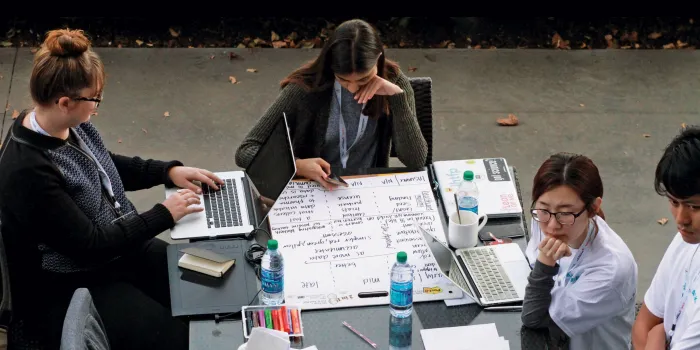GroupMe. Facebook’s “like” button. Carousell. These are just a few of the innovations that have emerged out of hackathons—collaborative, intensive conferences where people from different areas of expertise gather to create solutions to problems. On October 20–22, 2017, MIT Hacking Medicine, the National Hemophilia Foundation (NHF) and CSL Behring joined together for the first-ever Hacking Hemophilia.
The three-day event in Boston brought together 23 members of the bleeding disorders community, as well as 22 app developers, medical students, product designers, engineers, graphic designers and other innovators to learn and solve problems identified by the bleeding disorders community.
“The opportunity to bring together people in the bleeding disorders community to discuss unmet needs with outside problem-solvers was intriguing,” says Michelle Rice, senior vice president for stakeholder relations and public policy at NHF. “We were interested to see what new perspectives would bring.”
The event was run under the aegis of MIT Hacking Medicine, which has hosted medical and disease state hacks since 2011. MIT Hacking Medicine began the event with some rules and suggestions for a successful hack. NHF staff then gave the assembled hackers a broad overview of hemophilia, von Willebrand disease (VWD) and other bleeding disorders.
NHF recruited members of the community affected by hemophilia and VWD to participate and to make one-minute pitches identifying “pain points” to highlight what problems the hackers could try to resolve. There were more than 28 pitches, on topics ranging from identifying bleeds in babies to getting prompt treatment in the emergency room. After the pitches, teams of hackers formed as they explored the pain points they were interested in tackling.
That’s the value of applying the hackathon method to medicine, says Paul Chang, a senior member of MIT Hacking Medicine. “We knew we weren’t going to develop a cure. But by bringing together people with an accurate understanding and insight into the problem with people that have the technological ability to develop solutions, there are a lot of opportunities to improve the patients’ daily experiences.”
The next day, teams worked on solutions, with help from mentors if they hit snags. NHF staff answered questions on treatment and access to care. In the evening, the teams made practice pitches to members of MIT Hacking Medicine and the mentors, who gave feedback on everything from the quality of the solution to the tone of the pitch.
The next morning, the teams pitched their ideas to a panel of judges composed of leaders in the hemophilia community, including NHF CEO Val D. Bias, CSL Behring and members of the Boston technology community. The winning teams addressed the diversity of both the problems and the solutions: an app that gives personalized care; a peer-to-peer support network for immigrants with bleeding disorders; and simplification of delivery of ancillary treatment supplies designed to reduce waste and promote adherence. Winners received cash prizes and the opportunity to get future funding to pursue their projects.
NHF is looking forward to future hackathons in 2018. “You never know where the next great idea is going to come from,” says Rice. “We’d like to help make it happen.”

